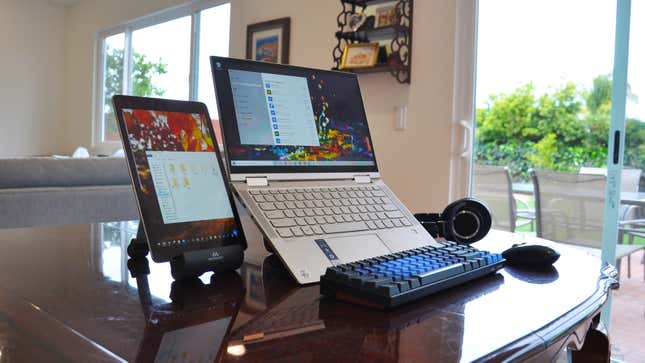
When most people picture “working from home,” they think of sitting on their couch in their bathrobe with a laptop and a mimosa. And sure, some days it’s exactly like that (don’t tell my editor). But most days, that’s not a great recipe for productivity.
If you plan on working from home, a dedicated office is ideal. But if you’re just starting to dip your toe into the telecommuting pool and don’t have a dedicated space for a desk, office chair, and desktop computer ... well, the dining room table will work in a pinch. You just need a few tools to make the experience more comfortable and compact.
First of all, your laptop’s screen is terribly positioned for long-term work. Ideally, you want the top your computer’s display to be around eye level, so you’re looking straight ahead—not down at the table.
The Nexstand is an adjustable stand that elevates your laptop to the ideal height, and you can fold it up when you aren’t using it. AmazonBasics has their own laptop stand for half the price, but it isn’t really adjustable or portable—the Nexstand is well worth the extra money if you want a workstation you can tear down at the end of the day (so you can actually use your dining room table for, you know, eating). Of course, a bunch of books will do a decent job for no money, too, so that’s always an (uglier) option.
If you want to go above and beyond, a second monitor can give you some more real estate on your screen to fit multiple windows. The jury’s out on whether this is a guaranteed productivity booster, but I’ve become so reliant on my two monitors that I always feel cramped when I’m stuck with one.
If you have an iPad or Android tablet, you don’t even need to buy a second display—just use an app like Duet Display to extend your desktop onto both screens (or use the Sidecar feature on your Mac, if you have a recent one). You might want a cheap stand to elevate your tablet, too, but other than that, all you need is a USB cable. (If you don’t have a tablet, there are portable monitors out there, though I haven’t had any experience with them myself.)
Once you’ve got your laptop elevated, you’ll probably realize that you can’t use the trackpad and keyboard very comfortably. That’s okay, since they were never that ergonomic to begin with. Instead, grab a wireless keyboard and mouse—external keyboards are far more comfortable to type on thanks to their deeper key travel, and mice are easier and more ergonomic than their touch-based counterparts.
As a mechanical keyboard enthusiast, I recommend the Velocifire TKL71WS for a somewhat compact, wireless option, but slimmer non-mechanical options like the Logitech MX Keys will work as well. As for mice, the Logitech MX Anywhere is my go-to wireless travel mouse, though if you have a bit more room to store your stuff, the MX Master is a killer upgrade for getting things done. (And while most of these will connect directly to your laptop over Bluetooth, you may need a USB hub if you plan on using the dongles instead.)
Finally, while it isn’t strictly necessary, a pair of headphones can go a long way when working from home—especially if you’re in a common area, like the kitchen or dining room. The last thing you need is constant distraction from kids running around, or your roommate binge-watching The Witcher while you’re trying to plow through work.
Any closed-back pair of headphones should drown out your surroundings well enough, though I’m a big fan of the Sony MDR-7506 for their affordable price, fantastic sound quality, and ability to fold up for easy storage. If you prefer a bit more of a “fun” sound, the venerable Audio-Technica ATH-M50x are a worthy alternative, albeit for a chunk of change more. (There’s also a wireless version, if you prefer to jam untethered.)
There’s one thing that’s hard to upgrade, unfortunately: your chair. That wooden dining room chair isn’t doing your back any favors, and while a detachable lumbar pillow like this can help somewhat, you’d be much better off with a real, adjustable office chair. The best office chairs are neither portable nor cheap—offerings from Herman Miller and Steelcase are close to $1,000—but they’re well worth it if you’re going to work from home.
If you can’t spring for those, AmazonBasics’ $75 option will do in a pinch, as will the $200 HON Exposure for a bit more. Alternatively, you could spend part of your time standing with a sit-stand riser like this one, though remember that standing desks still require some occasional sitting.
And there you go: with the exception of the chair, you’ve got a portable workspace that can go up at the beginning of the workday, and get stuffed in a bag at quittin’ time.
A setup like this isn’t perfect, of course—I find most dining room tables are too tall for me to type comfortably, but that’s something you’ll have to live with. (Heck, even most desks are too tall, which is why I built my own from a door slab and some IKEA adjustable legs.) But if you’re just starting to explore the idea for the first time, this inexpensive gear should get you up and running quickly, without the need for an entire home office.